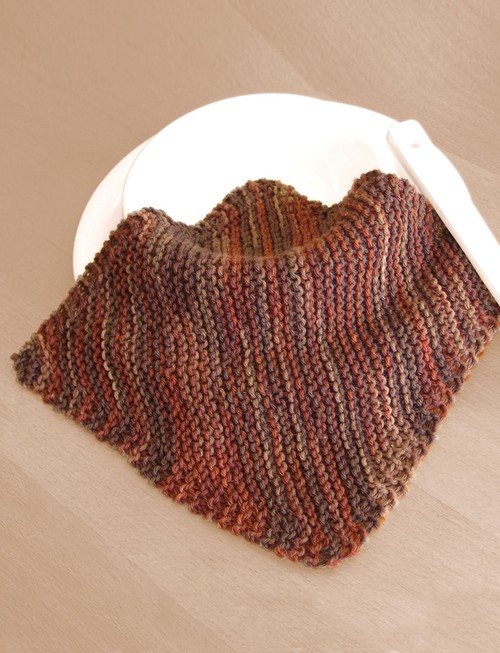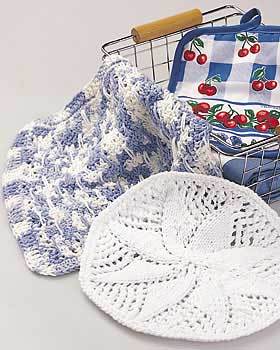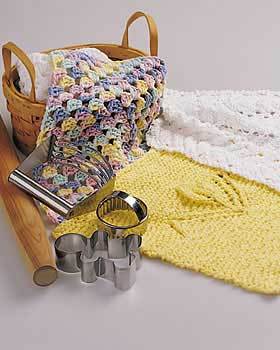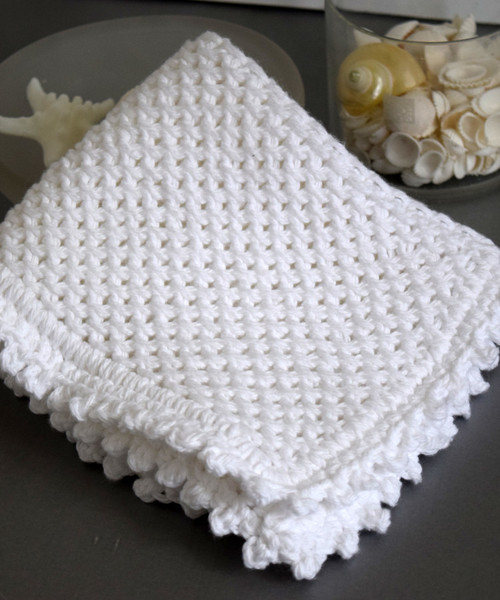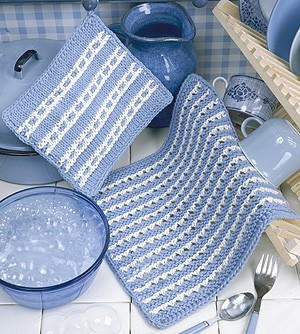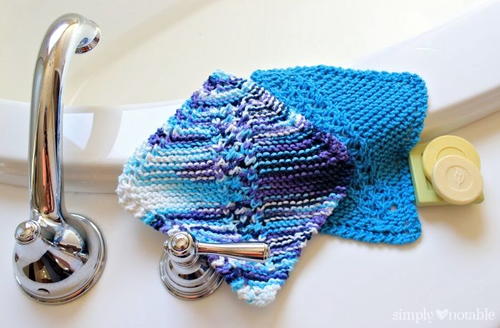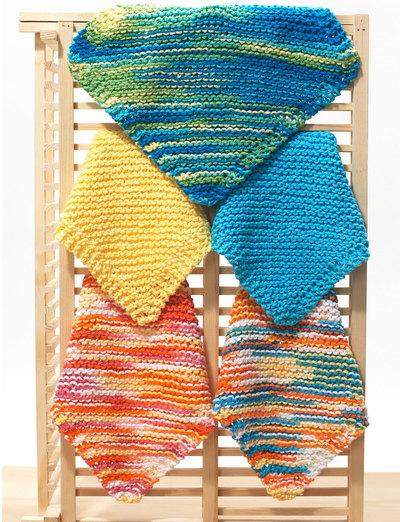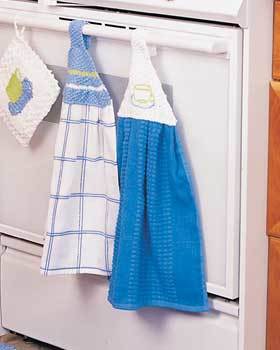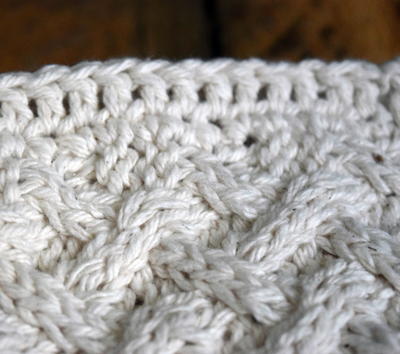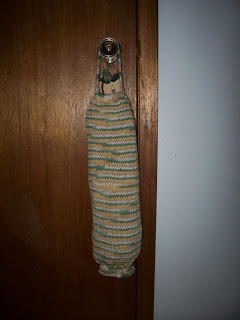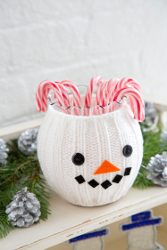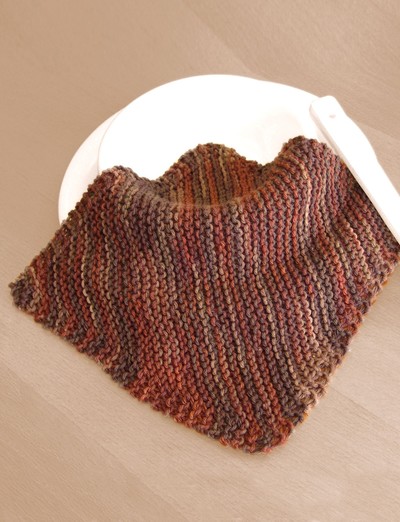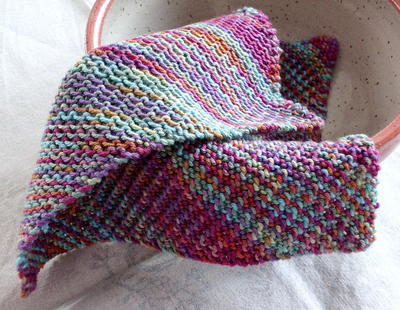Easy Dishcloth Knitting Pattern
If you're wondering how to knit a dishcloth, a diagonal knit dishcloth pattern is perfect for beginners.
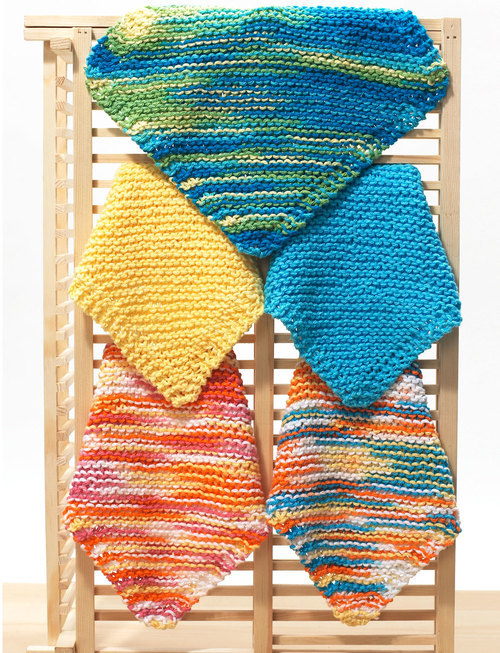
Create washable easy knit dishcloths in a variety of seasonal colors. These knitted dishcloth patterns are perfect knitting patterns for beginners. Best of all, they're easy to make, so the second one gets dirty, you can make another one. Use the colors suggested or create your own scheme to match the colors of your own kitchen decor.
This is a traditional diagonal knit dishcloth pattern that will teach you how to knit a project that produces a nice border effortlessly. After you learn to knit a beginner swatch that is simply rows of garter stitch, this pattern is a natural next step. You'll learn how to increase and decrease as you work this pattern diagonally.
No matter what, you'll be so glad you learned how to knit a dishcloth and saved money in the process. This easy knitted dishcloth is also a great gift idea for a new homeowner or renter, along with some handy knit scrubbies. Give one as a gift and the recipient will think of you whenever he or she is cooking in the kitchen.
One of the best things about learning how to knit a dishcloth is that you can easily learn how to make dishcloths that will actually match your kitchen space and decor. Just grab this free dishcloth knitting pattern and yarn skeins that will match your space and get to it. Knitting a dishcloth has never been easier! You will love the final result.

Knitting Needle Size10 or 6 mm
Yarn Weight(4) Medium Weight/Worsted Weight and Aran (16-20 stitches to 4 inches)
Gauge15 sts and 28 rows = 4" [10 cm] in garter st.
Finished SizeApprox 10" [25.5 cm] square.
Materials List
- Yarn: Bernat Handicrafter Cotton (Solids: 400 g/14 oz or 50 g/1.75 oz) or (Ombres: 340 g/12 oz or 42.5 g/1.5 oz).
- Requires: 40 g/1.5 oz of #33718 (Lazy Daisy), or #27620 (Hot Yellow), or #33742 (Blue Grass), or #27742 (Tropic), or #33745 (Summerset)
- Size 6 mm (U.S. 10) knitting needles or size needed to obtain gauge.
Getting Started: How to Knit the Garter Stitch
Learn how to knit the garter stitch with this video tutorial.
If you like these Easy Knit Dishcloths, then you'll love this collection of 12 Knitted Dishcloth Patterns. You'll find basic designs as well as ideas for more complicated knitting patterns. No matter your skill level, you'll find a cool pattern for your next knitting adventure. Get the collection:12 Knitted Dishcloth Patterns
How to Knit a Dishcloth
Check out this free knit dishcloth pattern for a simple and easy dishcloth that you can easily make in one afternoon or less.
Pattern:
Plus, More Knitted Dishcloth Patterns:
If this free knitting pattern was not exactly what you were looking for, we have plenty more free dishcloth knitting patterns to choose from. The links below offer some other options. Knit dishcloth patterns are fantastic because they are cheap, easy-to-make, and do not use up that much yarn. Plus, picking the right yarn for knit dishcloth patterns can result in a fantastically, scrubbing pattern.
Read NextBasic Cotton Dishcloth
Your Recently Viewed Projects
lcarr
Oct 26, 2018
This is such a classic pattern. I have made so many of these that I have lost count. It was one of the first patterns I ever learned to knit. I was about 8 years old at the time. You know you found a tried and true pattern when you find yourself going back to it repeatedly over more than 40 years!
carolyndoty 451935 6
May 25, 2017
What does (K1. Inc 1 st in next st.) mean? I think st means stitch, but I don't understand how to do what it says. Thank you
Editor Dana
May 30, 2017
Hi there! That means knit 1, increase 1 stitch in the next stitch. So after you knit the first stitch, you'll want to turn the next stitch into two (by increasing 1 stitch in the next stitch). You can do this in a variety of ways, such as knitting through the front and back loop (kfb). I hope that helps! -Dana from FaveCrafts
Daughter of Light
Feb 13, 2017
These wash cloths are so bright and cheery! I need to learn to increase and decrease and by the looks of things this may be the pattern for me to broaden my skills. I've been finding my yarn at my local charity shoppe so that means these are uber inexpensive for me to do!
Sue What
Dec 02, 2016
I love this pattern for making dishcloths! It is so simple and it's so easy to remember. It makes a great,durable dishcloth. Does anyone tried this pattern with that new yarn that is made for making dishcloths? I think it might be a rayon blend. I'm going to try it next time I need dishcloths.
quanahs 5032097
Mar 03, 2016
I love these little washcloth patterns. After knitting the endless muffler/scarf for what seemed like months, my mom started me on the diagonal dishcloths. Not only were they quick to finish, they were practical and used every day. I also learned how to increase and decrease while gaining confidence in my skills. If you can find the cotton yarn on sale, its cheaper than buying them.
dorishendricks 596 6352
Apr 20, 2013
ALSO, WHEN YOU READ PEOPLE'S COMMENTS ON FAVORITE PATTERS THAT WORK WELL FOR THEM, HOW DO YOU FIND THE ANSWERS TO THEIR QUESTIONS SO IT WILL ALSO HELP ME. I AM NEW AND LOVE LOOKING AT THE PATTERNS EVERY EVENING THROUGH THE WEEK. THANKS----DORIS HENDRICKS
FaveCrafts Editor JL
Feb 19, 2015
Hi Doris, Any answer to a reader-submitted question will be answered in a reply below the comment. Hope that helps! - Julia from FaveCrafts
dorishendricks 596 6352
Apr 20, 2013
ARE THERE ANY DISHCLOTH PATTERNS THAT YOU CAST ON ALL THE STITCHES AT ONCE INSTEAD OF HAVING TO KEEP ADDING ON. IT WOULD BE EASIER FOR ME. THANKS-----DORIS HENDRICKS
Cindykeen 7893830
Apr 26, 2013
I would like to know if there is an answer posted for this question and where can I find it?
Lisa
Jun 25, 2014
There are many patterns that call for a single cast on row-search them by putting dishcloth in the search bar.
carolandrobert 057 1771
Feb 14, 2019
I make this one a lot. Cast on 32 stitches. Knit two, purl two across to end. On the next row, repeat same pattern. On row three you purl two knit two across. Repeat the purl two knit two on row 4. Keep doing these four rows til your dishcloth is size desired. I believe it is called the moss or double seed pattern.
threebeansmombo
Sep 10, 2012
i am new to knitting and was just wondering is it suppose to be the same border all around I made one and two sides were the same and the other two were different i'm thinking that my increase one stitch might be wrong when i increased i picked the string inbetween than knitted that?? what kind of increase am i suppose to be doing/how thanks in advance
Lisa
Jun 25, 2014
You are correct-M1 (make 1 by picking up the yarn lying between two stitches) would not be correct here, you need to do an increase with either a Yo or a KFB, otherwise the fabric will be inconsistent and it will pucker and be too tight. I've made thousands of these and your increase must be a true increase where you add more yarn to continue, so it must be yo (yarn over needle) or KFB (knit front and back).
wendygoerl 2394329
Oct 09, 2014
The usual increase in this situation is to knit in the front and back of the stitch; i.e. you knit the stitch normally (in front), but instead of lifting the old stitch off, you knit another stitch into the back of the loop. A similar pattern released about 30 years ago used a YO to increase, but to keep the sides the same, this meant decreasing twice (once for the decrease, once to cancel the YO increase) in the second half.
lpzpayne 7329884
Apr 12, 2012
Knitting is a fascinating pastime Rewarding Useful Reading the comments of other knitters I wish I lived next door My experience with the Homecrafters yarn and pattern has developed over nearly thirty years I have found that the dishcloth which begins with cast on four stitches is very versatile Most of my friends to whom I have give dishcloths to prefer a smaller version I usually use a metric size needle Also I use circular needles for most of my projects To make the smaller size increase to - sts depending on the gauge it works to A group of ladies that I work with uses this same pattern excepting they work according to their supply of yarn If they have six ball of yarn as a sample of the same shade They follow the pattern until half of the yarn is used then they begin the decreasing and naturally that…Read More means when the arrive at only four stitches on the needle they cast off We give these squares to nursing homes and needy people I hope this gives another idea to all your readers Happy Knitting Aunt Polly
namiles 6102374
Jun 13, 2011
To Laddeehuskie: Could you give more information on how your mother knits the larger blankets, ie: number of cast on stitches, type of yarn used, etc. I would love to use this for charity blankets also.
ladeehuskie
Jun 12, 2011
My mother loves this pattern. She has used the same pattern, using larger needles and double strand worsted wool for blankets. Many of her Mizpah ladies make the blankets for charities. So far since January she has completed 9 of the blankets. She likes to make one a month for the church. She calls the pattern a "Remson" Blanket. It is a great way to use up her scraps of worsted, and has completed several that are queen size.
lerouxn 8892706
Feb 13, 2011
I would like to do this project but i can print it. What I have to do? lerouxn 8892706
victoriajomoody 83 90302
Dec 10, 2010
I cannot believe Im seeing this dishrag My best girlfriend passed away last year with cancer befor she was able to show me how to make these dishcloths mine is almost worn out she made them for me 2 years ago for christmas I told her over and over how great they were but she lived in another state. And when I went to see her I could not ever bring them up because she was to ill. I would if someone could do something to help me figure out how to knit these wash cloths so I could give them as gifts as she gave them to me and so I can replace mine!! Happy holidays
Crafter 18292
Jun 29, 2010
I LOVE this dishcloth it is my very favorite to use, make and give !
MegK31
Jun 26, 2010
I have used this pattern many times for b/blnkets and dish cloths. I do not count the stitches to get the size I want. Instead I measure the length of the border to get the length I want then I decrease. It is easier than counting stitches. I print a lot of patterns and find that the 3rd page usually has nothing of importance on it. So when setting up my printer I do NOT click on all pages instead I click on pages and then I put the number of the page I want to copy in the box. I start by copying page 1, then click on pages again and type 2 in the box. This way you don't print more pages than you want. Hope this helps
myster60
Jun 26, 2010
I use the same pattern; love the way it knits up and keeps it's shape...have made then for friends & family and they have come back for more.....have tried other pattterns but this is my favorite Priscilla
Crafter 8543137
Jun 26, 2010
I have used this pattern for years. what I like about it is that when these dishcloths are washed the shrink for easy storage then when they are put in water the spring back to their original size. This pattern is a varation of one that was published in workbasket many years ago.
crakihonoxa
Jun 13, 2010
I highlight the picture and text and paste it onto a word document. I do a lot of crocheting and knitting at the computer screen, so I save paper by reading off the screen. If I am travelling, I will select the section I am up to and print it out or jot it down on a note pad. That way I have a copy of the full article saved in case the one I am working on gets damaged!
Crafter 2554155
Mar 31, 2010
For printing instructions on 2pages. Select the info you want to print Right click print click on selection and then print Sometimes it does want to do this, be persistent....it works
Lynn48
Mar 06, 2010
I usually highlight what I want and right click over the hightlighted text and choose print. When the printer window comes up I choose selection under page range (instead of All). Just did this and got 2 pages instead of three because of spacing. A better option, which takes more time, is to choose copy instead of print. Then you can paste it into a word processor document and do some formatting to make it more concise before you print it.
Bette G
Mar 06, 2010
I printed out this pattern and was surprised to print 3 pages. Is there a way to print just the instructions and not all three pages. This is wasting paper. Thanks
Dosidobev
Jan 11, 2010
I used one skein for the increase side and one for the decrease side making a baby blanket. Some leftovers of other baby fine yarn will be making same blankets for granddaughters dolls.
Member 15903
Oct 09, 2009
I used this pattern, and love it. Right now I am using this same pattern, using Bernat Softee Baby and Baby Jacquard left over balls, to make a baby blanket. This pattern can easily lend it's self to many other ideas with a bit of imagination. And it's quick and easy enough anyone can do it.
Report Inappropriate Comment
Are you sure you would like to report this comment? It will be flagged for our moderators to take action.
Thank you for taking the time to improve the content on our site.


